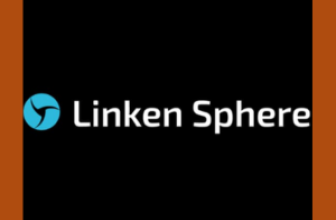Proven in practice: Multilogin and experts test it daily
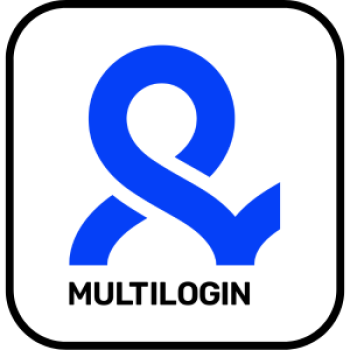
Multilogin X continues the tradition of the first anti-detection browser on the market, launched by Estonian entrepreneurs in 2016. Over the course of nearly a decade, Multilogin has undergone several revolutions, and today I want to share my experience of using the updated version for a month. It’s no secret that Multilogin has a solid reputation as a working application that has been around for quite some time.
Unlike the previous version, Multilogin 6, the new Multilogin X is now only a web application that requires a desktop agent to work. Thanks to these changes, the product has become more accessible to beginners, but the question remains: does Multilogin X live up to its reputation as the “Mercedes-Benz of anti-detection browsers”?
In this review, I will share my detailed experience of using Multilogin X for a month, analyze the new interface, automation features, API capabilities, and anti-detection system. I will also provide an honest comparison with other anti-detection browsers and help you decide whether Multilogin X is worth the money.
Why Multilogin X is easier and more profitable for startups
- Works even on Linux 🐧 — unlike many competitors.
- Built-in resident proxies 🌍 — no need to search for and purchase them separately.
- Security and trust 🔒 — European company, GDPR compliance, automatic data deletion 3 months after subscription ends.
- 24/7 support in 5 languages 🕑 — help is always at hand.
What’s new in Multilogin X?
Multilogin has now introduced a fundamentally new approach to anti-detection browsing. The development team has completely reimagined the product, creating it from scratch based on more than ten years of experience. First, let’s take a look at the key changes that define the new generation of this tool.
Migration to a web application and desktop agent
The most significant change was the transition from a fully desktop application to a hybrid solution—a cloud-based web interface for managing profiles combined with a local desktop agent for launching them. This architecture allows you to access your account from any device, but you still need to have the agent installed to actually launch profiles.
This solution has both advantages and disadvantages. On the one hand, the web interface provides greater flexibility and mobility when managing profiles. On the other hand, installing the desktop agent can cause certain difficulties, especially on Mac devices with older versions of the operating system.
Multilogin X vs Multilogin 6 Comparison
Multilogin 6 is gradually becoming a thing of the past — it is only available to existing users, and new subscriptions are no longer being sold. Overall, Multilogin X offers significantly expanded functionality:
- Two browser engines — Stealthfox or Mimic based on Firefox and Chrome, respectively.
- Access to all features via API endpoints (in the old version of Multilogin 6, API capabilities are limited).
- Built-in proxy service: free resident proxy traffic in every subscription.
- Proxy traffic savings and group proxy management.
- Three fingerprint masking modes — automatic, customizable (manual), and using real data.
- Ability to restore deleted profiles from the recycle bin.
- Quick AI commands to speed up your work.
- Instead of CookieRobot, a system for adding ready-made cookie files has been implemented, which significantly increases the trust factor for user profiles. You can choose any of the available platforms, such as Facebook, Amazon, Google, Ebay, Etsy, Bing.
- Extended role system for team members.
- Compatibility with operating systems — MacOS, Windows, Linux, Android.
MacOS 14+ support and limitations
One of the significant limitations is the increased operating system requirements. Unlike the previous version, Multilogin X only supports macOS 14 Sonoma and newer, while Multilogin 6 worked on older versions up to macOS 12 Monterey.
At the same time, Multilogin X is fully compatible with Apple laptops running on M1, M2, M3, and M4 (Apple Silicon) chips. When downloading the agent, it is important to select the correct version: “M-series” for devices with M-series chips and “Intel” for other models.
Some users encounter problems when installing the agent on a Mac due to Apple’s security checks. To resolve these issues, you need to change your security settings or temporarily disable Gatekeeper. However, it is important to remember that Multilogin is only designed for desktop devices and does not support mobile devices such as phones and tablets.
Features and interface: how Multilogin X works
At the top of the screen is a universal search bar, which also serves as a panel for quick AI commands. By default, it works like a regular search — just enter the profile name, and the system will instantly filter the results.
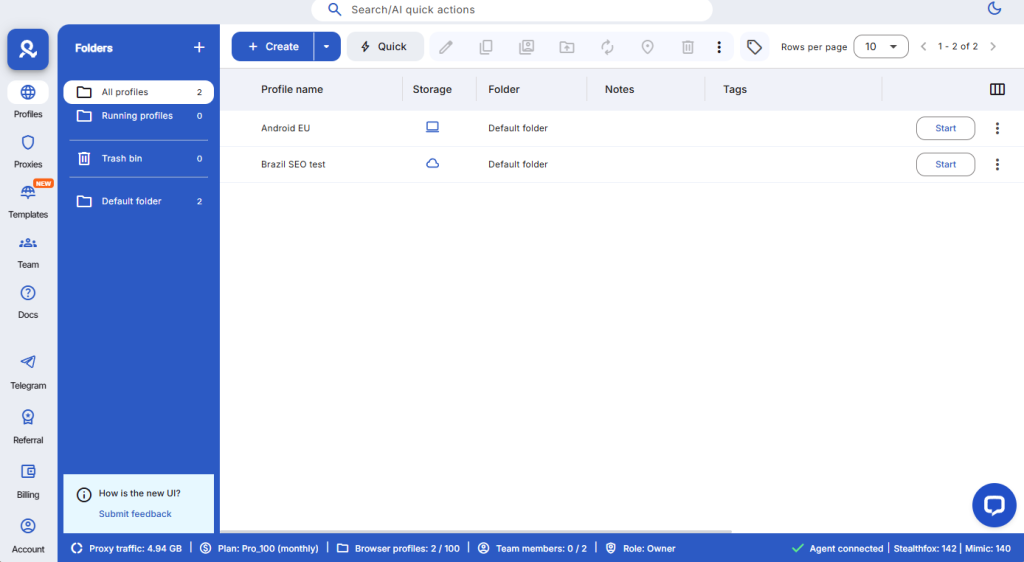
On the left is a sidebar with the main sections: Profiles, Proxies, Team, Docs, and Account settings.
In the Profiles section, you can switch between the Default folder, Trash, and your custom folders. The new Running Profiles feature shows all running profiles, including one-time ones, allowing you to quickly stop them or copy their ID.
Importing profiles and configuring proxies manually
Profile import now allows you to upload up to 10 profiles simultaneously in .zip format. Cloud profiles can be up to 100 MB in size, while local profiles can be up to 2 GB each. Only the account owner has the right to import profiles.
Proxy configuration has become much more convenient. Multilogin X offers built-in proxies with access to over 30 million premium residential and mobile IPs. There is no need to mess with external proxy settings. Every Multilogin subscription includes free resident proxy traffic, ensuring smooth management of multiple accounts without the risk of being blocked.
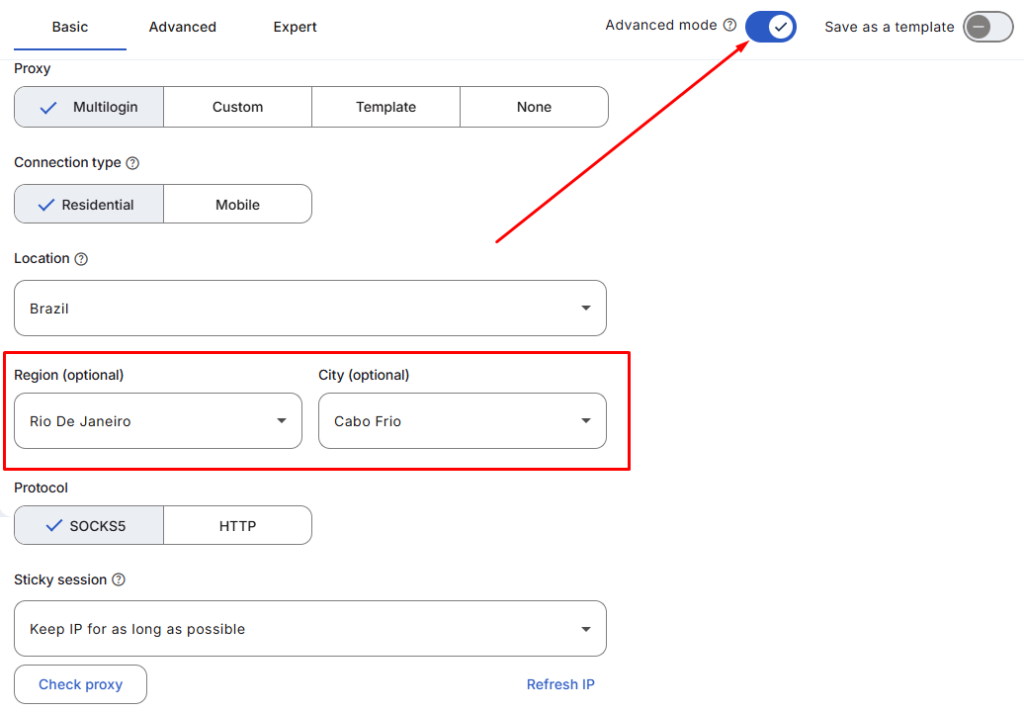
To configure the proxy, simply open the profile settings, select “Multilogin” as the type, and specify the desired location. In advanced mode, you can select the connection type (mobile or resident), region, city, and protocol (HTTP or SOCKS5).
AI commands and action automation
One of the most impressive new features is quick AI commands. To activate this mode, type @ai in the search bar and press Enter. You can then enter commands in natural language, for example:
- “Launch all profiles in group ‘TestGroup1’” — launches all profiles from the specified group.
- Launch the profile “Profile name.”
- Create 3 one-time profiles with proxies from different countries.
- Create 2 Mimic profiles with proxies from the US and UK.
- Rename the profile or create a new folder.
- “Clone profile ‘TestGroup1’ 10 times with different proxies” — clones the profile with new proxies.
This feature turns everyday operations into quick text commands, saving time and eliminating multiple clicks.
Mobile fingerprints and Android profiles
New mobile profiles in Multilogin X simulate access via Android devices. They are read by websites as users opening the site from a smartphone, which is especially important for platforms that display different content on mobile devices. Multilogin does not simply change the User-Agent to mobile. The platform creates a full-fledged Android environment within the desktop browser: touch events instead of mouse clicks, Android-specific fonts, mobile network emulation (3G/4G/5G).
To create an Android profile, click “New Profile,” enable “Advanced Mode,” and select “Android” as the operating system. It is important to note that you cannot convert a desktop profile to a mobile one — such profiles must be created from scratch. It is also worth considering that these are not full-fledged Android emulators — you cannot install applications; these are only browser environments in mobile form.
Mobile profiles are especially useful for working with platforms such as Instagram, TikTok, and LinkedIn, where it is important to appear as a smartphone user for natural interaction with services.
Proxies, fingerprints, and security
Security in Multilogin X is based on a comprehensive approach to anonymity. This protection system allows you to work effectively with multiple accounts without raising suspicion from websites and platforms.
Built-in resident and mobile proxies (sticky IP)
Multilogin X offers built-in proxies, providing access to over 30 million premium resident and mobile IPs. These proxies are available directly from the profile settings, eliminating the need to connect third-party providers. Paid subscribers receive bonus traffic with no expiration date. Resident proxies use real IP addresses issued by Internet service providers, making actions appear as if they were performed by real users. The geographical coverage is impressive — more than 150 countries and 1,400 cities. The “sticky IP” feature is especially valuable, allowing you to keep one IP address for up to 24 hours, which is critical for long sessions.
Step-by-step fingerprint verification: Iphey, Pixelscan
Tools (what to use):
- Whoer (IP) — quick check: does the IP match the supposed location? This page opens by default when you launch your profile.
- Pixelscan — detailed check of browser fingerprint, IP/proxy, DNS leaks, and signs of automation.
- BrowserLeaks — search for minor leaks and inconsistencies (WebRTC, canvas, userAgent, plugins, etc.).
- Iphey — basic integrated check (browser, geolocation, IP, hardware/software).
- MaxMind — the most accurate geolocation data by IP.
How to check a fingerprint — brief instructions:
- Open the desired profile in Multilogin.
- Run one of the tools: Whoer, MaxMind, Pixelscan, or BrowserLeaks (or several in turn).
- Compare key parameters: IP address and geolocation (Whoer ↔ MaxMind), Browser version and userAgent, OS version and hardware properties, WebRTC/DNS leaks, canvas/AudioContext, plugins, and extensions.
- Record any discrepancies found (e.g., IP in another country, userAgent does not match the browser version, DNS leaks detected).
- In Multilogin, edit the profile: proxy/geolocation, userAgent, hardware settings, engine parameters, etc.
- Repeat the check until there are no critical inconsistencies left.
No need for CookieRobot
Now you don’t need to collect cookies manually — Multilogin provides ready-made cookie sets that can be quickly imported into your profile to make it look “old” and natural without manual collection. You can choose any of the sets for Facebook, Amazon, Google, Ebay, Etsy, Bing, and so on.
Ready-made cookies (CookieRobot) substitute sets of cookie files for popular sites and a general set called “Others” into your profile, saving time and increasing the realism of your profiles. Are the cookies the same for all users? No, each set is unique.
How to use:
- Open your profile settings in Multilogin.
- Find the “Pre-made cookies” section.
- Select a website from the list or select “Other” to get a general set of cookies, and suggest adding your website by entering its name.
- Click “Import” — the cookies will be loaded into your profile and will be active the next time you launch the program.
Use ready-made cookies as a base — after importing, warm up the profile with natural behavior (visits, cookie saving, interaction). This will further reduce the risk of detection and increase account stability.
How to check cookies in your browser:
- For Mimic: enter chrome://settings/content/all in the address bar.
- For Stealthfox: enter about:preferences#privacy → select “Cookies” → “Manage data”.
Fingerprint masking: 25+ parameters
Multilogin X replaces over 25 digital fingerprint parameters, including Canvas (an HTML5 element used for hidden fingerprinting), WebGL (an interface for 3D graphics that provides data about the video card), AudioContext (a sound generator in the browser), and fonts. Each profile creates a unique and complete set of data — a digital fingerprint of the device. However, the Passive OS (TCP/IP fingerprint) is formed at the connection level, and Multilogin cannot change it. However, most websites do not use this information due to frequent discrepancies.
Automation and Multilogin X API — briefly and simply
The Multilogin X API provides remote access to all functions — launch a profile, specify a proxy, download cookies, etc. To get started, simply obtain an authorization token by logging into your account and passing it in the request headers.
The API integrates easily with automation: you can launch profiles for Selenium, Puppeteer, or Playwright — the choice depends on the task (Selenium — for compatibility, Puppeteer — for fast Mimic scraping, Playwright — for modern scripts and CI).
It is also possible to create and configure profiles in bulk (up to several at a time), with cookie isolation and individual fingerprint settings — convenient for working with a large number of accounts.
How to register and download MultiLogin X
Unlike many services, MultiLogin does not offer a free trial period — you can only use the platform after paying for a subscription. The registration process is as follows:
- Go to the official MultiLogin X website and select “Pricing” from the top menu.
- Choose your plan: you can subscribe for a month or pay for a year up front — the latter option is more cost-effective.
- Enter your email address, select a payment method (bank cards and various cryptocurrencies are supported), and, if necessary, enter the promo code 50MLSALE — it reduces the cost of the first month by 50%.
- After successful payment, you will be able to set a password and access your personal account, where you can install the program and configure profiles.
💡Tip: before choosing a plan, think in advance about how many browser profiles you will need. If your project is just starting, the smallest package will be enough, and as you scale up you can easily switch to a higher plan.
Pricing and plans: is it worth the money?
When choosing an anti-detect browser, pricing plays a crucial role. Multilogin X offers several subscription options that differ in functionality and limits for various use cases.
Free plan and paid subscriptions
First of all, Multilogin X offers a budget-friendly way to explore the platform — a three-day trial for €1.99, which includes 5 profiles with both cloud and local storage, as well as 200 MB of premium proxy traffic. This is a great opportunity to test the core features before purchasing a full subscription.
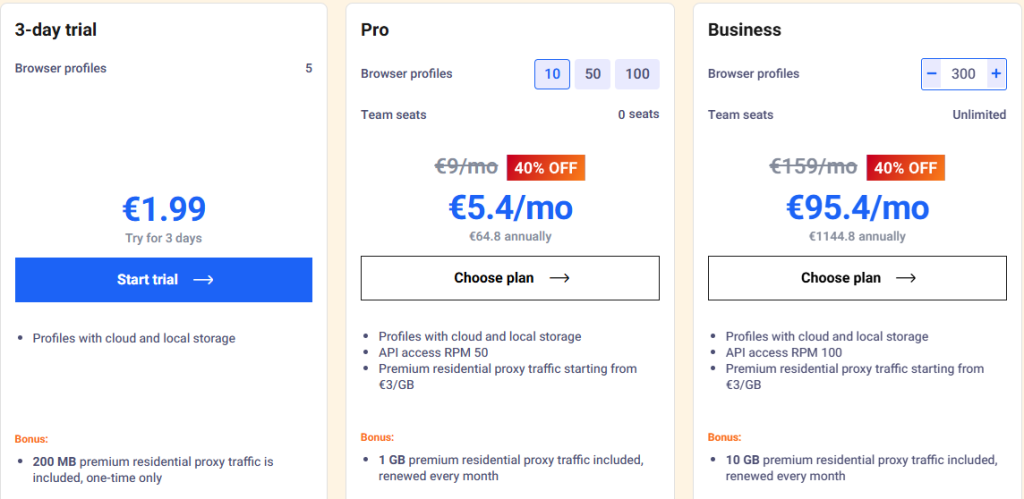
The basic Pro plan with 10 profiles costs €9 per month. For more active users, there is a plan with 50 profiles for €49/month, while the version with 100 profiles is priced at €79/month. Corporate users can opt for the Business plan, starting at 300 profiles for €159/month.
Multilogin accepts payments by card, cryptocurrency, through the Payssion system, and by bank transfer. The system automatically sends reminders about subscription renewals before debiting funds, which helps avoid unexpected payments.
What’s included in each plan: proxies, profiles, API
All paid subscriptions include access to profiles with cloud and local storage, as well as API functions with various request per minute (RPM) limits. The Pro plan with 10 profiles provides 1 GB of premium proxy traffic per month for free, the version with 50 profiles increases this amount to 3 GB, and the plan with 100 profiles increases it to 5 GB.
The Business plan, in addition to 300+ profiles, features an unlimited number of team members and 10 GB of monthly proxy traffic. It is especially valuable that all included traffic is for premium residential proxies.
Additional proxy traffic can be purchased at a price of €3 per 1 GB. Unlike many providers, Multilogin does not reset unused traffic — it is saved and carried over to subsequent periods with no expiration date.
It is important to note the data storage policy — profiles and settings are stored on cloud servers even if payment is missed. According to the terms of use, the company stores data for 3 months after the subscription ends, after which it may be permanently deleted.
The key advantage of Multilogin X is that there are no restrictions on the number of devices. Regardless of the type of subscription, the anti-detection browser can be used on multiple computers, which is especially convenient for distributed teams.
Comparison of Multilogin X with other anti-detection browsers
Currently, the anti-detection browser market is flooded with various solutions, each with its own advantages and disadvantages. When analyzing Multilogin X in relation to its competitors, it is important to note its positioning as a premium tool with a corresponding price tag.
Compared to its closest analogues, Multilogin X is more expensive. Many competitors offer more generous free plans. Of all the solutions reviewed, Multilogin X is positioned as the most versatile thanks to its ease of use and premium proxies included in every plan.
| Comparison criteria | Multilogin X | Dolphin Anty | Undetectable |
|---|---|---|---|
| Trial before purchase (free plan/trial) | 3-day paid trial €1.99 | Upon registration, 5 free profiles (limited functionality). | Free plan with 5 cloud profiles (limited functionality). |
| Price (from) | ≈ €9/month | ≈ $89/month | ≈ $49/month |
| Number of browser profiles (in the basic plan) | 10 profiles with cloud and local storage. | Up to 100 browser profiles. | Local profiles: unlimited. Cloud profiles: 50. |
| OS | Windows, macOS, Linux | Windows, macOS, Linux | Windows, macOS |
| Cloud launch (cloud profiles) | Yes | Yes | Yes |
| Teamwork | Shared access and roles starting from PRO100 plan (€79/month). | Available, configured in the browser. | Available via an additional cloud panel. |
| Beginner-friendliness | Medium learning curve | User-friendly interface | Easy start |
| Proxy integration / built-in proxies | Built-in premium proxies (1 GB monthly). External proxies can be connected. | Easy integration of external proxies from 5 providers. Manual setup possible. | Integration only with ASocks. Manual setup possible. |
| Support & updates quality | Regular updates, 24/7 support in 5 languages. | Frequent updates, support in EN/RU. | Regular updates, support in EN/RU. |
| Final rating (max. 10) | 8.5 | 7.5 | 7.1 |
In fact, by choosing Multilogin X now, users pay a premium price for reputation, stability, and advanced security features that are especially valuable for large projects and companies with high reliability requirements.
Conclusion
Summing up the test results, Multilogin X truly lives up to its reputation as the “Mercedes-Benz of anti-detection browsers.” Despite its higher price compared to competitors, the quality of fingerprint masking and stability are top-notch. Without a doubt, the transition to a web interface with a desktop agent was a significant step forward in the browser’s development!
I was particularly impressed by the effectiveness of the AI commands and the CookieRobot feature. In fact, these tools saved me hours of routine work when setting up and warming up profiles. Premium residential proxies with bonus traffic are also a compelling argument in favor of choosing this particular platform.
However, it’s worth admitting that for beginners and small projects, the cost of Multilogin X may seem excessive. Nevertheless, with an annual payment, you can get a substantial discount, which makes the offer more attractive. And for testing, use our promo code.
Developers should pay attention to the powerful API and integration with popular automation frameworks — Selenium, Puppeteer, and Playwright. Thanks to these capabilities, Multilogin X becomes not just a tool for manual profile management, but a full-fledged platform for large-scale projects.
Support for Android profiles deserves a special mention — a feature that significantly expands the possibilities for working with mobile versions of websites and applications. Thus, Multilogin X offers the most complete set of tools for anonymous online work, albeit at a premium price. A month of active use has convinced me that this tool is definitely worth the money for serious projects.
FAQs
Multilogin X is a new generation of anti-detection browser introduced in 2025. Unlike previous versions, it works as a web application with a desktop agent, offers advanced automation features, an improved fingerprinting system, and built-in premium proxies.
Yes, Multilogin offers a trial subscription: 3-day trial period: for only €3.99, you get access to Multilogin X with basic features for 3 days, including: 5 browser profiles (available in both cloud and local storage) 200 MB of resident proxy traffic.
Multilogin X spoofs over 25 digital fingerprint parameters, including Canvas, WebGL, and AudioContext. It also provides access to resident and mobile proxies, tools for checking masking effectiveness (Iphey and Pixelscan), and the CookieRobot feature for creating realistic browsing histories.







